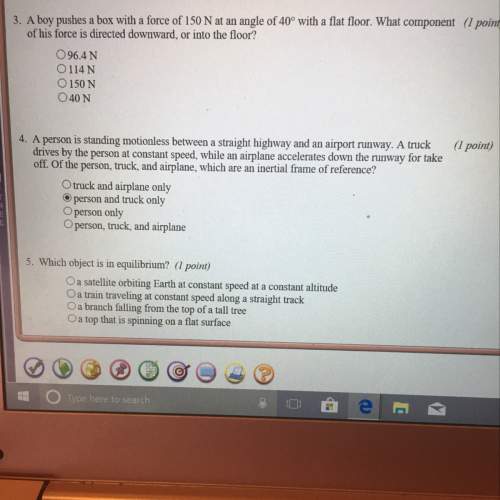
Physics, 31.07.2019 10:00, brandon1888
While two forces act on it, a particle of mass m=3.2kg is it to move continuously with velocity (3m/s)i - (4m/s)j . one of the forces is f1 = (2n)i + (-6n)j . what is the other force?

Answers: 1
Other questions on the subject: Physics

Physics, 23.06.2019 00:00, jeffro198004
You notice the birds sitting on the electrical wires which of the following explain why the birds don't get shocked
Answers: 2

Physics, 23.06.2019 08:00, weeblordd
Use henry's law and the solubilities given below to calculate the total volume of nitrogen and oxygen gas that should bubble out of 1.7 l of water upon warming from 25 ˚c to 50 ˚c. assume that the water is initially saturated with nitrogen and oxygen gas at 25 ˚c and a total pressure of 1.0 atm. assume that the gas bubbles out at a temperature of 50 ˚c. the solubility of oxygen gas at 50 ˚c is 27.8 mg/l at an oxygen pressure of 1.00 atm. the solubility of nitrogen gas at 50 ˚c is 14.6 mg/l at a nitrogen pressure of 1.00 atm. assume that the air above the water contains an oxygen partial pressure of 0.21 atm and a nitrogen partial pressure of 0.78 atm.
Answers: 2

Physics, 23.06.2019 14:50, kaffolter25
Onsider a u-tube whose arms are open to the atmosphere. now, equal volumes of water (ρ = 62.4 lbm/ft3) and light oil (ρ = 49.3 lbm/ft3) are poured from different arms. a person blows from the oil side of the u-tube until the contact surface of the two fluids moves to the bottom of the u-tube, and thus the liquid levels in the two arms are the same. if the fluid height in each arm is 31 in, determine the gage pressure the person exerts on the oil by blowing. (round the final answer to three decimal places.)
Answers: 3

Physics, 23.06.2019 19:00, hearteye769
Aspherical ball of charged particles has a uniform charge density. in terms of the ball's radius r, at what radial distances inside and outside the ball is the magnitude of the ball's electric field equal to 14% of the maximum magnitude of that field? a)inside the ball: b) outside the ball:
Answers: 3
Do you know the correct answer?
While two forces act on it, a particle of mass m=3.2kg is it to move continuously with velocity (3m/...
Questions in other subjects:


English, 27.01.2021 18:10




English, 27.01.2021 18:10



Mathematics, 27.01.2021 18:10







